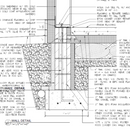Water control at foundation – placement of perimeter drainage
Hello,
Reviewing available resources (BSC, EPA, etc), the perimeter drainage pipe is placed on the outside of the foot of the footer. By foot of the footer I mean the bottom, wider part of the footer. Would there be a disadvantage of placing that drainage pipe right on top of that foot? Supposedly that would be easier – less excavation for the builder. Please comment. From the BSC article I see that they would like to connect the interior drainage pad (coarse gravel) with exterior perimeter drainage via several pipes through footing; if our drainage pipe sat above it it would not be good. But the main reason given in the article to use piping through footing is for the redundancy in the event of perimeter drainage clogging. Water would then be removed by the interior sump pump. We do not plan to have the sump pump… nor any interior drainage. It should be noted that we are on about 10% grade hill and the southern part of the building ends up at ~8” below ground, whereas the northern wall of the lowest level is mostly underground.
Is the perimeter drainage sufficient in this “half” basement condition or should we worry about the interior drainage too? This is in Pittsburgh, PA, rather wet weather, but hilly region.
Here is my reference:
http://www.buildingscience.com/documents/bareports/ba-1015-bulk-water-control-methods-for-foundations
I also attach our footer with original placement of perimeter drainage, not yet at the footer’s foot.
GBA Detail Library
A collection of one thousand construction details organized by climate and house part











Replies
Lucyna,
This question has come up several times on GBA before. In fact, Scott Gibson wrote an entire article on the topic. Here is the link:How to Install a Foundation Drain.